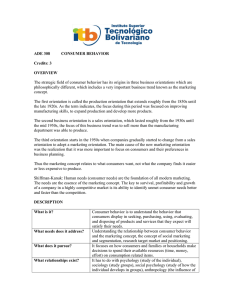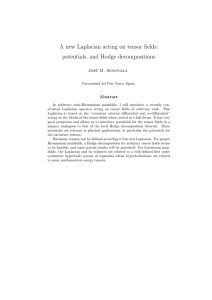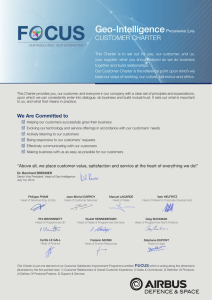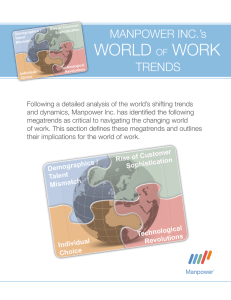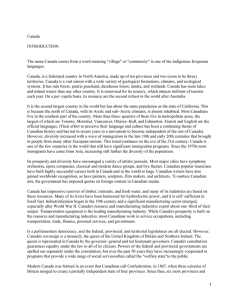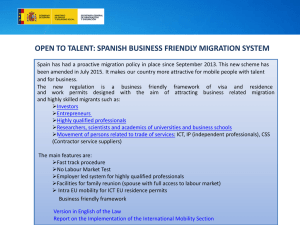Identifying High Potentials in the Workplace: A Research Report
Anuncio
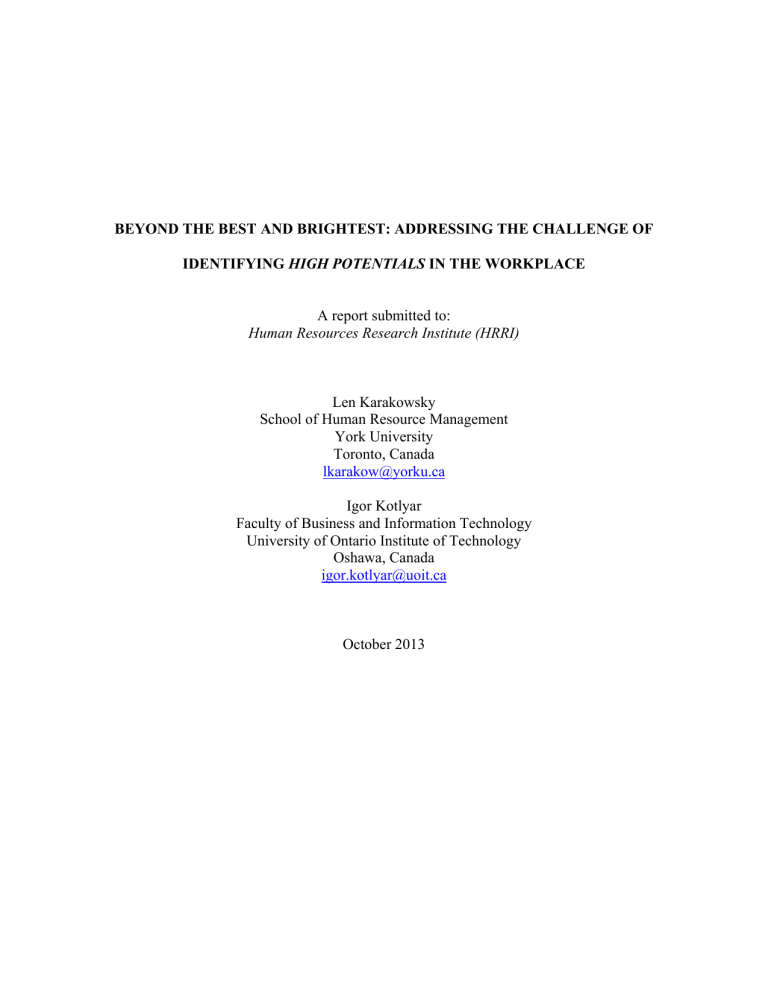
BEYOND THE BEST AND BRIGHTEST: ADDRESSING THE CHALLENGE OF IDENTIFYING HIGH POTENTIALS IN THE WORKPLACE A report submitted to: Human Resources Research Institute (HRRI) Len Karakowsky School of Human Resource Management York University Toronto, Canada [email protected] Igor Kotlyar Faculty of Business and Information Technology University of Ontario Institute of Technology Oshawa, Canada [email protected] October 2013 1 INTRODUCTION Many companies attempt to identify high-potential (HIPO) talent early in their employees’ careers and they invest heavily in nurturing this talent (Collings & Mellahi, 2009; Slan Jerusalim & Hausdorf, 2007). As Church and Waclawski (2010) have pointed out, the ability to accurately and consistently identity high potentials is one of the “holy grails” of Idustrial-Organizational psychology. Our main focus of research has been to develop a better understanding of how and how well Canadian organizations identify high-potential employees and the impact of such identification on employee behaviour and organizational performance. The HRRI grant allowed us to substantially expand our “high potentials” research agenda by moving it from a university laboratory into the field. We believe that the research we were able to undertake, with the assistance of this grant, has made a valuable contribution to the practice of identifying high potentials. More specifically, the HRRI research funding has helped us conduct the following research pertaining to the “high potential” agenda: 1. Conducted experimental studies on the effect of “high potential” labeling on risk-seeking and task commitment and published findings in Leadership & Organization Development Journal (in print) and Europe’s Journal of Psychology (2013) 2. Conducted a Canada-wide survey of HR professionals regarding the structure of “high potential” programs and their level of satisfaction. Analyzed the results and published findings in the Canadian HR Reporter (Dec 2011) and Journal of Management Development (in print) 3. Conducted in-depth interviews with senior managers from a wide variety of organizations, including Torstar, Harlequin, Target Canada, Shoppers Home Health Care, Johnson & Johnson, to explore their approaches and practices to “high potential” identification. We are currently completing a working paper for submission to an academic journal based on this data. 4. Conducted detailed analysis of “high potential” practices inside a Canadian division of a Fortune 500 company. We conducted 40 interviews and analyzed company employee data. A research paper based on this data was accepted for presentation at The 8th Biennial International Conference of the Dutch HRM Network, Leuven, Belgium. 2 FINDINGS We examined “high potential” identification practices and its effects from two different perspectives: An organizational-level and an individual-level. At the organizational level, we identified areas that need to be addressed in order to further improve the HIPO identification system (for example, see our summary below of our recent work published in the Journal of Management Development and in a presentation at the 8th Biennial International Conference of the Dutch HRM Network). At the individual level, we identified several important behaviorial consequences of the HIPO labeling process (for example, see our summary findings for our paper published in Leadership and Organizational Development Journal). HIPO PROGRAMS: ORGANIZATIONAL LEVEL PERSPECTIVE Little is known about how organizations actually form their perceptions of their HIPO programs and what elements of these programs determine satisfaction. This information is crucial in order to achieve a fuller understanding of how such programs could be improved. Thus, the purpose of one of our studies was to explore the factors that determine organizations’ satisfaction with their HIPO programs. Our objective was to examine how HR professionals, the function that tends to oversee the design and implementation of talent management programs, perceive their high-potential programs. More specifically, we investigated what perceptions drive satisfaction with HIPO identification programs. Our results suggest that respondents form their impressions through three perceptual lenses. The first lens is that of effectiveness – How accurately are high-potential employees being identified? The second lens is that of fairness – How fairly does the HIPO program treat employees? The third lens is that of motivation – Does the HIPO program motivate or demotivate employees to perform? While the business case for HIPO programs frequently boils down to the importance of accurately identifying future leadership talent (i.e., effectiveness), our results indicate that perceptions of fairness and motivation associated with the HIPO program can be critically important as well in determining satisfaction with these programs. Thus, all three perspectives contribute significantly to organizational satisfaction with HIPO practices. 3 For example, while research shows that an employee’s current job performance is not an accurate predictor of potential to perform in higher-level roles, organizations nonetheless tend to rely disproportionately on this indicator to make talent calls (Karakowsky & Kotlyar, 2011). If this approach has been shown to be flawed from an accuracy perspective (i.e., effectiveness) and organizations are advised to use other indicators of future potential instead, then why do most organizations continue to place so much weight on current job performance? The answer to this puzzling question, according to our results, may be that the use of current job performance has perceived value from the motivation perspective. Consequently, as long as organizations believe that relying on current performance has motivational benefits, they are unlikely to improve the effectiveness of their HIPO identification process by assigning greater weight to future-oriented indicators. What elements of a HIPO program are associated with satisfaction? Our results suggest that the degree of formalization of the organization’s approach toward identifying high-potentials is the most impactful factor, as it is positively associated with all three perceptual lenses: Effectiveness, fairness and motivation. Thus from a practical perspective, organizational efforts to systematically identify HIPOs appears to be the most important single element of a HIPO program. The actual details of the program appear to be less important. The use of evaluations by an upper-level manager was negatively associated with perceptions of fairness. Perhaps the respondents felt that managers, who were not their immediate supervisors, were less able to accurately assess their potential. It would be interesting to explore this finding in future studies. Interestingly, the use of additional assessment tools, such as personality measures, IQ, EQ, and learning agility, was seen as more fair and perhaps less biased, although not necessarily more effective in terms of accuracy. In other words, these assessment methods may not be seen as highly effective for predicting future potential, but are also not seen as subjective or biased. Consistency and transparency were also positively linked to satisfaction through perceptions of fairness and motivation, respectively. We found that the more consistently the HIPO identification process was applied across the organization, the more perceived fairness was evident which in turn impact perceived satisfaction with the program. Likewise, greater 4 transparency was associated with employees’ motivation to perform, contributing, in turn, to higher level of satisfaction. From a practical perspective, our results suggest that organizations should be primarily concerned with implementing a formal, systematic approach to HIPO identification. (These findings are reported in more detail in the Journal of Management Development) HIPO PROGRAMS: INDIVIDUAL LEVEL PERSPECTIVE Among our research initiatives, we explored the workings of a “high potential employee” program at a Canadian division of a Fortune 500 company and its impact on employee careers. This research was guided by two research questions: How (and when) are employees identified as “high potentials”? ; What are the consequences of being identified as a “high potential” on an employee’s career? The analyses were based on quantitative and qualitative data. Access was obtained to the company employee records, including talent calls, performance appraisals, and participation in leadership development programs. As well, two sets of in-depth interviews were conducted: First, 12 interviews with Senior Managers and Directors, who were involved in the process of high potential identification and development; and second, 20 interviews with Middle Managers, most of whom were identified as high potential employees. As part of the analyses, the career progression of employees classified as high potentials was compared to their non-high potential counterparts. The data revealed that being identified as a high potential has a considerable impact on employee careers. Most employees, who are classified by the company as high potentials, receive this special status early in their career, based on their managers’ judgment of their “leadership potential”, and tend to retain this classification as they move up in the organization. In contrast, failure to be classified a high potential within the first 12-24 months on the job is associated with a greatly diminished likelihood of attaining such classification. Once identified as a high potential, employees are presented with opportunities for greater visibility and exposure to top leadership. They also have more weight placed on their opinions. In some cases, high potentials even appear to enjoy special enhancements to their regular performance ratings as the result of their high 5 potential status. High potentials also receive greater access to leadership training and development programs. Although there is no clear evidence that such programs improve their actual performance (as reflected in no significant change in their performance ratings before and after training), according to our interviews with Senior Managers and Directors, these programs serve as exceptional networking opportunities that are critical to progression within the organization. Finally, high potential employees tend to expect and receive more frequent and higher level promotions. (These findings are reported in more detail in the paper prepared for the 8th Biennial International Conference of the Dutch HRM Network, Leuven, Belgium) We have explored how status-based labels, based on future capabilities can impact people’s risk tolerance in decision-making. We developed and tested theoretical arguments using a set of three studies employing a scenario-based approach and a total of 449 undergraduate business students. The findings suggest that labeling people in terms of future capabilities can trigger perceptions of public scrutiny and influence their risk preferences. Specifically, the results reveal that individuals who are recipients of high-status labels tend to choose lower risk decision options compared to their peers. Organizations are concerned about their future leadership capacity and often attempt to grow leadership talent by identifying high-potential employees early on. The results of the study described above suggest that such current practices may have an unintentional negative effect of reducing high-potentials’ tolerance toward risky decision making, thus potentially impacting these future leaders’ decision making in the realm of corporate strategy, R&D, etc. The issue of how labeling individuals in terms of future capabilities can impact their risk preference has been largely ignored by organizational research. This study suggests that the popular practice of identifying high-potential employees may have unintentional negative effects by lowering their risk tolerance. (The findings are reported in more detail in the paper published in the Leadership & Organization Development Journal) 6 We conducted an experiment to explore the effects of labeling individuals in terms of their performance potential on their personal expectations and attitudes following performance feedback. In our laboratory study of 477 undergraduate business students, we examined the effect of “high potential” expectations on task commitment and satisfaction following positive and negative feedback. Our results indicate that such labels can make individuals more sensitive to feedback and consequently create unintentional negative effects on commitment and satisfaction. (The findings are reported in more detail in the paper published in Europe’s Journal of Psychology) CONCLUSIONS In sum, we hope our research has contributed to furthering knowledge on the topic of HIPO programs. To date, the topic seems to be very much a “black box” with little substantive understanding of the dynamics of these programs, what works and what doesn’t and how they impact employees. Our aim was to take research further into the field in order to assess the dynamics surrounding the assessment of high potential. Our research underscores the need to generate a more reliable and accurate measure of high potentials via two paths. First, we need to expand the degree to which the HIPO measure captures relevant factors beyond individual level competancies. Second, we need to expand awareness of the biases inherent in HIPO assessment. What should companies do to improve their eye for talent? First, they need to properly evaluate the effectiveness of their high-potential programs. As simple as this may sound, most companies don't do it. While organizations recognize the importance of leadership development, we found that only a tiny percentage had systematically evaluated the accuracy of their identification process. The vast majority had no way of knowing if their bets payoff. Second, companies need to review their criteria for leadership potential. Many companies identify high-potentials simply on the basis of performance in their current position, as opposed 7 to looking at the competencies required for success in higher-level positions. Yet, research has shown that less than one-third of all high-performing employees have the critical abilities to excel at the next level in the organization. Finally, given that high-potential identification is typically based on subjective managerial recommendations, companies should provide formal training to the assessors. In our research, few respondents indicated that senior managers in their companies were “highly effective” at picking potential stars. DISSEMINATION OF FINDINGS Refereed Publications Kotlyar, I., Karakowsky, L., Ducharme, M.J., & Boekhorst, J. (in press). Do “rising stars” avoid risk?: Status-based labels and decision making. Leadership & Organization Development Journal, 35(2). Kotlyar, I., & Karakowsky, L. (in print). Sources of satisfaction with high-potential employee programs: A survey of Canadian HR professionals. Journal of Management Development. Kotlyar, I. (2013). The double-edge sword of “high potential” expectations. Europe’s Journal of Psychology, 9(3), 581–596. Kotlyar, I., & Karakowsky, L. (2013). Assessing the potential of high-potential programs. Proceedings for the Academy of Business Research conference, 121. Practitioner Publications Kotlyar, I., & Karakowsky, L. (2013). Innovation in leadership development: A lesson from the Executive Roundtable. HR Edge, 4. Karakowsky, L. & Kotlyar, I. (2012). Do ‘high-potential’ leadership programs really work? The Globe and Mail. Karakowsky, L. & Kotlyar, I. (2011). Think you know your high potentials? Canadian HR Reporter, 24(21), 23. Kotlyar, I., & Karakowsky, L. (2011). Properly identifying high potentials. Canadian HR Reporter. 8 Academic Conference Presentations Kotlyar, I. (upcoming 2013). Career path of a "high potential": An analysis of a Canadian division of a Fortune 500 Company. The 8th Biennial International Conference of the Dutch HRM Network, Leuven, Belgium. Kotlyar, I., & Karakowsky, L. (2013). Assessing the potential of high-potential programs. Academy of Business Research Conference, New Orleans. Kotlyar, I., & Karakowsky, L. (2012). Rising stars and falling commitment. Academy of Management Annual Conference, Boston. Kotlyar, I., Karakowsky, L., Ducharme, M.J., Boekhurst, J. (2011). Do high-potentials prefer to play it safe?: The influence of perceived expectations on risky decision making, IOBC Conference (sponsored by the Academy of Management), Tel Aviv. (Best Paper Finalist) Professional Conferences and Presentations Kotlyar, I. (2012). High-potential programs in Canada. The Canadian Talent Management Summit, Toronto. Kotlyar, I. (2012). The academic world and assessments for high performers. Invited presenter at the Predictive Success seminar, Oshawa. 9 RESEARCH SHORT BIOGRAPHIES Len Karakowsky is a Professor of Management at York University. He earned his Ph.D. from the Joseph L. Rotman School of Management at the University of Toronto. Professor Karakowsky’s research has been published extensively in such journals as Leadership Quarterly, Journal of Applied Psychology, Administration and Society, Journal of Management Studies, Group and Organization Management, Journal of Management Development, Small Group Research, Journal of Management Systems, International Business Review and many others. In 2004, he assisted in establishing York University’s Master’s program in human resource management. He has written several books and coauthored the text Business and Society: Ethics and Stakeholder Management (First Canadian Edition) for Thomson Nelson Publishers as well as The Context of Business (forthcoming, 2014) for Pearson Publishers. Igor Kotlyar is an Assistant Professor at the Faculty of Business and IT at the University of Ontario Institute of Technology. Dr. Kotlyar earned his PhD from the Joseph L. Rotman School of Management, University of Toronto. Professor Kotlyar’s current research focuses on identification and development of “high potential” employees. His research has been published in a range of internationally renowned academic journals, including The Leadership Quarterly, Journal of Leadership & Organizational Studies, Journal of Management Development, and Leadership & Organization Development Journal. Professor Kotlyar's professional experience includes successfully launching two technology companies. One of his companies developed simulation-based software for training, selection, and recruitment of employees. It was the first company in the world to build an online video simulation assessment and was widely covered by the media for its innovation.

